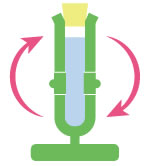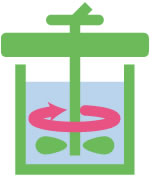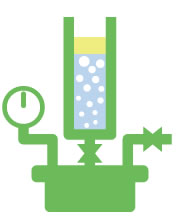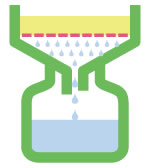Himoloc
How to select Himoloc
Conduct pre-test check such as pH, SS, ignition loss and appearance of the raw water.
Common measurement parameters: Dosage, flocculation speed, floc form/strength, separated liquid SS, turbidity, color, etc.
The dosage of flocculant is based on the necessary sedimentation speed, which can be derived from the on-site processing equipment. The necessary sedimentation speed V is found using the below formula.
V> (Q1-Q2) ÷S x F V = Minimum sedimentation speed (m/Hr)
Q1 = Raw water flow rate ㎥/Hr Q2 = Sludge discharge (㎥/Hr)
S = Sedimentation vessel surface area (㎡) F = Drift safety rate (1.3 to 1.5)

Test Methods
Cylinder Test
Place the raw water sample in a graduated cylinder, add the stipulated dosage of Himoloc, close the lid of the cylinder and turn upside down 10 times at a fixed interval to mix the contents. Afterwards, measure and observe the level of sedimentation at fixed intervals.

Jar Test
Place the raw water sample in beakers, add the stipulated dosage of Himoloc solution, then use a jar tester to mix the contents of the beakers for 30 seconds to 1 minute at 150 to 200 rpm. After the additional 1 minute mixing under the rotation speed of 70 rpm, measure and observe the necessary items such as the average diameter of flocs, sedimentation speed, turbidity of supernatant.

Floatation Test
Add the stipulated dosage of Himoloc to the raw water sample, mix under set conditions, transfer it into the upper cylinder of a floatation tester, introduce pressurized water (0.2 - 0.4 mPa) from underneath (volume = 20 to 50% of the overall volume), observe the floatation status of the flocs and take the necessary data.

Nutsche Test
Place the sludge sample in a beaker, add the stipulated dosage of Himoloc, then mix under set conditions. After observing the form, size, strength of the flocs, pour into a Buchner funnel with belt filter cloth, measure the amount of separated liquid at a fixed interval of time and observe the filtration status.

Press Test
Place the cake obtained after the Nutsche test on the filter cloth for pressing, put another filter cloth on top of the cake, sandwich from above and below with perforated plates and pressurize under set conditions. Then measure and observe the spread, detachment, water content and so on of the cakes.
(Choose the filter cloth depending on the type of dehydrator)

Centrifugation Test
Take a fixed amount of the sludge sample, add the stipulated dosage of Himoloc, mix with a high-speed mixer, then place the flocculated sludge in a table centrifugal decanter. Operate the decanter at a speed of 4000 rpm (approx. 900G) for 60 seconds then observe the status of the cakes and filtered liquid, determine the water content of the cakes and SS recovery rate.
Belt Concentration Test
Follow the same procedures as the Nutsche test and calculate the concentration magnification from the measured separated liquid.
Centrifugation Concentration Test
Place the sample in a beaker, add the stipulated dosage of Himoloc, then mix under set conditions. After observing the form, size, etc. of the flocs, separate in a centrifugation machine, measure the amount and SS of the supernatant liquid and calculate the concentration factor.
